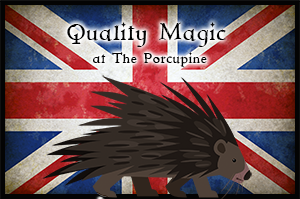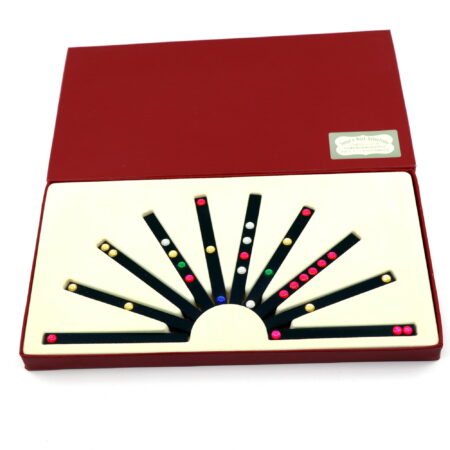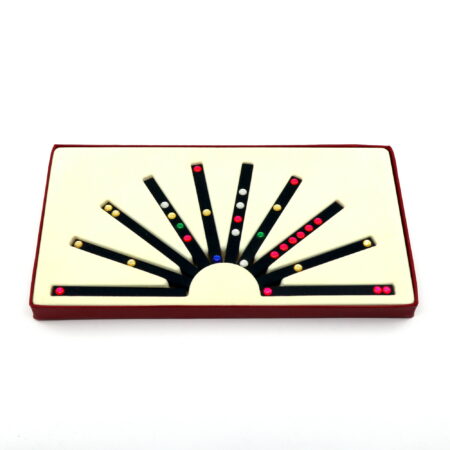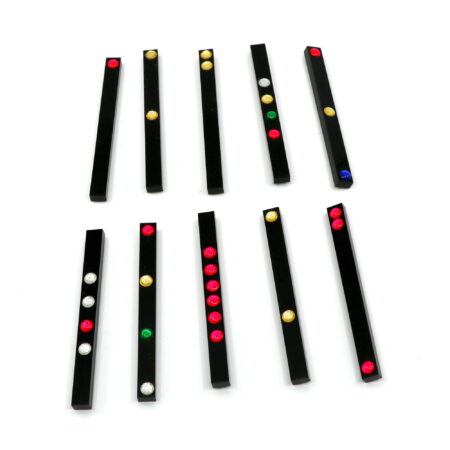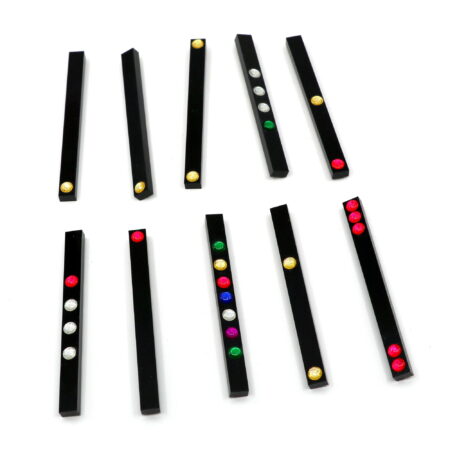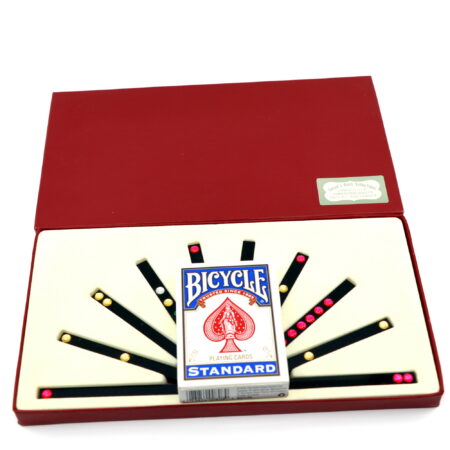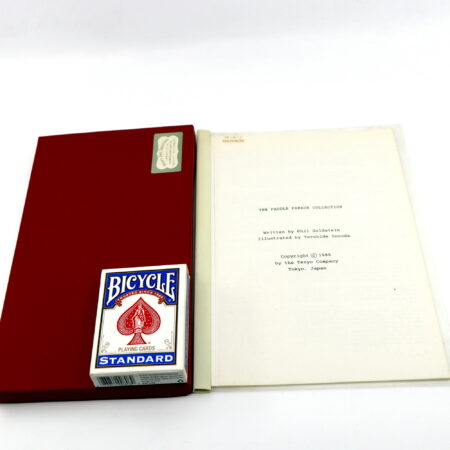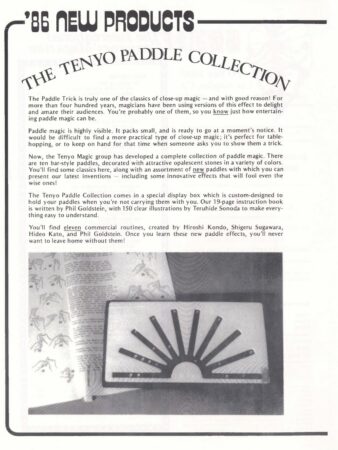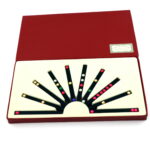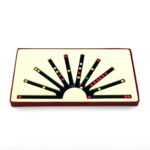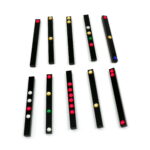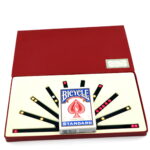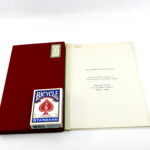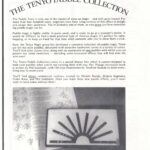Description
This is Tenyo’s highly sought after Paddle collection. Also included are the 19 page of instructions written by Phil Goldstein and illustrated by Teruhide Sonoda.
I have read through the clearly written and well illustrated instructions multiple times and attempted to perform each of the 11 effects presented and here are a few brief comments. When you first look at the ten paddles you think what a cute set of bar paddles, but each of the paddles has a very specific purpose and it is quite incredible how amazing some of the routines are thanks to the placement of gems in certain locations. Although none of the paddles has any sliding parts or items added or removed, if you bother to read through the routines I’m quite sure you will find some effects that appeal to you and are easy to perform.
Brief comments (see some effect details below):
- Warm-Up: Easy to do and short and sweet.
- Solo: Easy to do and quite a step up from the warm-up.
- Duet: More involved but with a little extra practice this is a very baffling and interesting routine.
- Trio I: This one sounds very interesting and does not seem particularly difficult. I was able to do the basic moves but I am not convinced I could ever make this look good, spectators would want to see more of the paddle. For those with more talent maybe this would be amazing, but I would need to see it to be convinced. It relies on covering up one of 4 gems in the center of the paddle and I am uanble to do that without screaming: “What is under your thumb!” 🙁
- Trio II: This is very different from Trio I (using a different paddle) but I like it. Takes a little more practice but still possible and amazing how much they can get out of a single fixed paddle.
- Trio III : This is based on Trio I and does not work for me for the same reason. I am not sure this would look convincing without seeing it.
- Quartet I: This is too tricky for me to do well. Done well it is amazing but I don’t have the time to put in or possibly the ability to make it look good. Check out the YouTube video above to see how good it can look – Victor makes it look easy 🙂
- Quartet II: This is certainly easier than Quartet I. It requires some fluid handing but is not difficult and with some practice you have a great little routine that is different.
- Sextet: This is the popular Hot Rod effect with an improved force of the red spot. This is not a bad idea but it doesn’t do much for me.
- Canon: This is another effect that requires quite a lot of motion with the hands being in the right place at the right time. With effort probably looks good, but not for me.
- Concerto: This is probably the most involved effect I would (or could) perform and it is quite an amazing sequence of events for sure.
Effect: The Paddle Trick is truly one of the classics of close-up magic – and with good reason! For more than four hundred years, magicians have been using versions of this effect to delight and amaze their audiences. You’re probably one of them, so you know just how entertaining paddle magic can be.
Paddle magic is highly visible. It packs small, and is ready to go at a moment’s notice. It would be difficult to find a more practical type of close-up magic; it’s perfect for table hopping, or to keep on hand for that time when someone asks you to show them a trick.
Now, the Tenyo Magic group has developed a complete collection of paddle magic. There are ten bar-style paddles, decorated with attractive opalescent stones in a variety of colors. You’ll find some classics here, along with an assortment of new paddles with which you can present our latest inventions – including some innovative effects that will fool even the wise ones!
The Tenyo Paddle Collection comes in a special display box which is custom-designed to hold your paddles when you’re not carrying them with you. Our 19-page instruction book is written by Phil Goldstein, with 150 clear illustrations by Teruhide Sonoda to make everything easy to understand.
You’ll find eleven commercial routines, created by Hiroshi Kondo, Shigeru Sugawara, Hideo Kato, and Phil Goldstein. Once you learn these new paddle effects, you’ll never want to leave home without them!
The effects included are:
- Warm-Up: A simple effect to start off. A yellow stone appears on a previously blank paddle, jumps from end to end, eventually changing into a red stone.
- Solo: (Shigeru Sugawara) This basic effect has a single stone jumping from end to end on the paddle and eventually appearing magically in the center.
- Duet: (Jamison/Allen; later released as “Diamond and Ruby”) This is the classic two-paddle effect originally released by Jamison and modified by Allen. Yellow stones jump from stick to stick and end to end and eventually a red stone appears at the climax.
- Trio I: (Hideo Kato) Three white stones on the paddle change one at a time into red, green, and yellow.
- Trio II: (Toshio Akanuma; originally released as “Three Gems”) The effect begins with a single yellow stone in the center of the paddle. It is magically joined by a red stone, which jumps around. Eventually a blue stone also appears.
- Trio III: (Phil Goldstein) A variation on Trio I; the paddle is shown to have two white stones and one red. The red stone hops around from position to position and eventually vanishes, leaving three white stones.
- Quartet I: (Hiroshi Kondo) Four different-colored stones appear one at a time as if by magic.
- Quartet II: (Phil Goldstein) A clever version of the then-popular “Crosstown” paddle trick with an added climax of the one red stone jumping to a chosen position.
- Sextet: (Hiroshi Kondo) This effect is a notable improvement on “Hot Rod,” doing away with the transparent count/spell force normally used.
- Canon: (Toshio Akanuma; originally released as “Sutekina Sapphire”) A single stone is seen on the paddle. It rather remarkably seems to slide all over the rod until eventually four stones of the same color are revealed.
- Concerto: (Sugawara/Kondo) A single stone mysteriously multiplies to three, one of the stones jumps around, and then two of the stones vanish.
(Notice: Includes: Printed Instructions.)
( Post Source: martinsmagic.com - click for details )